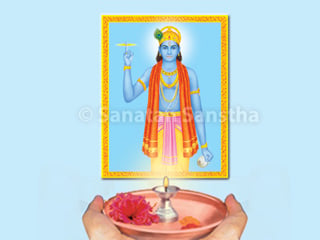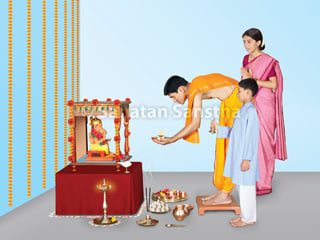Aspects necessary to make an Arati sattvik and full of bhav (Spiritual emotion) !
1. Bhav of the individual singing Arati
Sattvikta and bhav in the Arati depends upon the bhav of the individual singing it. The more the bhav of the individual singing the Arati for God, the more the Arati becomes enriched in bhav and sattvikta. Such an Arati reaches the Deity faster. The individuals who sing an Arati in this manner obtain the following benefits :
1. If the collective bhav during Arati is high, then waves of the Chaitanya (Divine consciousness) of the Deity remain in the environment for a longer period, leading to reduction in the distress caused by negative energies and getting the benefit of Chaitanya
Every individual should make an effort to perform Arati with bhav. The greater the collective bhav, greater will be the extent and period of preservation of the waves of Chaitanya of Deities in the environment. Also, a sheath is created on the ground by these sattvik vibrations, which blocks the distressing waves emitting from Patal (Hell region). Consequently, the individual gets maximum benefit of Chaitanya. Thus, while performing Arati, physical as well as subtle bodies of the worshipper are purified, resulting in faster spiritual evolution.
– A Scholar (Through the medium of H.H. (Mrs) Anjali Gadgil, 5th June 2005, 6.33 p.m.)
(All may not have a high level of bhav. To enable those with less bhav to perform Arati with bhav, Sanatan Sanstha has made available an audio cassette and CD in Marathi – ‘Collection of Arati and Ramrakshastotra and Marutistotra’. This collection includes regular Arati of Shri Ganapati, Deity Shiva, Shriram, Shrikrushna, Deity Datta, Shri Vitthal and Shri Durgadevi. These Aratis have been sung by H.H. (Mrs) Anjali Gadgil and other seekers of Sanatan Sanstha with a high level of bhav. Hence, they are enriched with bhav, Sattva component and Chaitanya. According to the Principle that ‘word, touch, form, taste, odour and the associated energy coexist’, if everyone sings the Arati in a similar manner, it will help in awakening their bhav. – Compiler)
2. Pronunciation of words and the method of singing
The Sattva component and Chaitanya generated by the words in the Arati depend on the pronunciation, pace of pronunciation and pronouncing the words together or separately. To illustrate this point, an example of how different pronunciation in an Arati results in changing the Sattva component emitted by the words is given here.
A line in Shrikrushna’s Arati is as follows –
‘ध्वजवज्रांकुश ब्रीदाचा तोडर ।’
(Dhwajavajrankush bridacha todar).
This can be sung in the following methods :
Method 1 : ‘ध्वजवज्रांकुश ब्रीदाऽचा तोडर ।’ Here ‘da’ in the word ‘bridacha’ is prolonged.
Method 2 : ‘ध्वजवज्रांकुश ब्रीदाचाऽ तोडर ।’ (dhwajavajrankush bridacha todar) Here ‘cha’ in the word ‘bridacha’ is prolonged. By uttering the word ‘bridacha’ in a straight tone without any change in rhythm, the Sattva component generated by the word is 100 percent. However, when singing the Arati, since there is restriction on the rhythm, we have to sing them by prolonging a specific alphabet in a word.
When this word is uttered as in method ‘1’, 80 percent Sattva component is generated. However, when the same word is uttered by method ‘2’ only 60 percent Sattva component is generated.
This example illustrates the importance of correct pronunciation of every word in any song. Only if the pronunciation is correct, it is possible to awaken bhav. If an alphabet in the middle of a word is prolonged, then the last alphabet in the word has the capacity to bind the sound waves created by prolonging the middle alphabet. Hence, such words generate more Chaitanya, which lasts longer too.
In contrast, if the last alphabet in a word is prolonged, then as there is no alphabet following it, the sound waves created in such a word are not held together. Instead they disperse immediately into the atmosphere. As a result, the Chaitanya in them lasts only momentarily and we do not obtain the desired benefit from the Sattva component in it.Hence, it is more beneficial to prolong the middle alphabet than the last one. In the advanced stage of spiritual progress, singing in a straight tone bestows more inner Anand and Shanti (Peace) than singing it with rhythmic changes.
– ‘A Scholar’ (Through the medium of H.H. (Mrs) Anjali Gadgil, 19th January 2004, 10.59 a.m.)
The audio-cassette and CD – ‘Collection of Aratis and Shriramraksha stotra and Marutistotra’ is very useful in learning how to pronounce the words. It is also beneficial in learning the manner in which some regular Aratis should be sung so that they become Sattva-predominant.
3. Singing the Arati after understanding its meaning
Most Aratis have been composed by Saints and evolved devotees. At times, it is difficult to understand the meaning of Aratis composed by evolved Saints.However, singing Aratis after understanding their meaning helps in early awakening of bhav towards Deities.
Given here is a spiritual experience of a seeker, on singing of an Arati after understanding its meaning.
Awakening of bhav after concentrating on the meaning of the Arati
Everyday during Arati,after concentrating on the meaning of the Arati and sound of cymbals, I experience sensation from the feet to the head. With each step of this sensation,my bhav gets awakened. After this, I experience a lot of enthusiasm and energy. This state of awakened bhav lasts a long time after the Arati. – Ms. Meghana Waghmare, Devad Ashram, Panvel, Maharashtra.
(When the bhav of a worshipper is awakened, he is able to imbibe the Chaitanya emanating from God. Consequently the worshipper’s enthusiasm increases. – H.H. Dr. Jayant Athavale)

 Deepajyoti Namostute !
Deepajyoti Namostute ! The science underlying blowing a conch prior to Arti
The science underlying blowing a conch prior to Arti Complete act of performing Arti
Complete act of performing Arti How to offer Arti?
How to offer Arti?